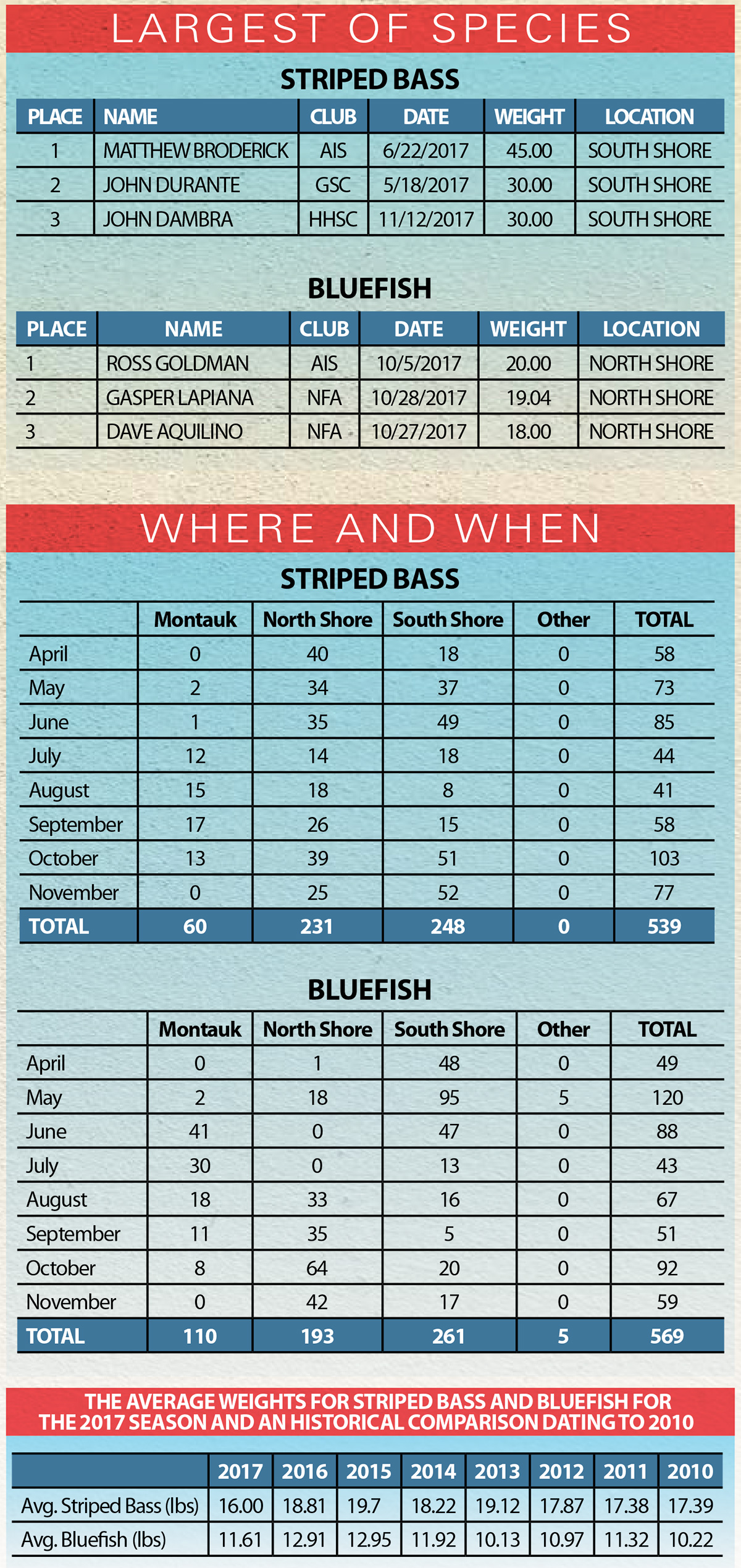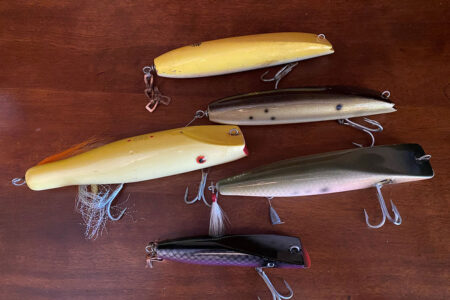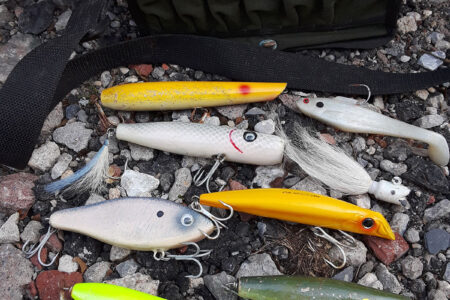
The 2017 New York Surf Fishing Contest (NYSFC) included 12 fishing clubs with High Hill Striper Club gaining top honors with 2,143 points, which were 236 points better than runner-up Farragut Striper Club with 1,907. Gateway Striper Club finished third with 1,891 points. In the Released Fish category, High Hill Striper Club ran away to a first-place finish with an impressive 7,998 points. Traditional Surfcasters came in second with 3,145 points followed by North Fork Anglers with 2,609 points. Austin Rutcofsky of Atlantic Surfcasters claimed the top spot in the Individual Standings (1,017) besting Matthew Broderick of All-Island Surfcasters by 141 points. Ross Squire of Traditional Surfcasters was third with 521 points, Nicholas Palesty (Farragut Striper Club) was fourth with 478 points and John Durante (Gateway Striper Club) rounded out the Top 5 with 436 points. Barbara Kehlenbeck of North Brookhaven Sportfishing Club hit the trifecta finishing first in the Women’s Division for striped bass, bluefish and weakfish.
In total, there were seven anglers achieving the Gold Pin level (>400 points) – down from 13 in 2016, 15 anglers reaching the Silver Pin level (>200 points) – down from 18 in 2016 and 27 anglers at the Bronze Pin level (>100 points) – up from 19 anglers last year.
Top Anglers
So how did Austin Rutcofsky and Matthew Broderick achieve the top spots? In speaking with both, they offered some interesting comments: There is just no substitute for time on the water. Both Austin and Matt typically spend more than four days/nights on the water during the season and then kick it into high gear fishing just about every day in November. All in all, both Austin and Matt agreed that this was a rough year and that it was very difficult to find any consistency from one outing to another. Matt had a pretty productive spring but found tough going in the fall. Most of Austin’s point fish came from a few outings a month; he recalled one night out in Montauk where he landed a number of nice point fish only to find no luck the following night with the same exact conditions.
Most of Austin’s success was fishing in the back bays and inlets – not the open beach. Both Austin and Matt rely heavily on bucktails; additional choices include SP minnows and darters. Matt’s largest fish came on an eel. Austin found that given the lack of consistent blues and striped bass some guys in his club targeted other fish – fluke and chunking sharks off the beach.
Both Austin and Matt found the large number of small striped bass in the fall to be one of the few promising signs from this past year.
The year 2017 saw inconsistent fishing throughout Long Island’s surf. For the third year in a row the lack of a significant showing of sand eels on the north and south shores contributed to inconsistent overall results. Bluefish made their customary arrival on the South Shore in May but never really showed in any great numbers in the fall. This might be partly to blame for the less than stellar number of larger bass during the fall months. While we saw promising signs in the very large number of schoolies in October and November, the Montauk fall run never materialized. In total only 13 striped bass were entered from Montauk in October and November.
In summary, it took many anglers a very large commitment of time and effort to produce positive results in the surf this year. For the third year in a row, the following section remains valid: “… the numbers included in this report do not include a much-overlooked statistic — catch per unit effort or the amount of effort required to catch fish.” To a man, the great majority of anglers queried reported needing to invest substantially more time on the water to produce the fish they catch compared to previous years. It is very difficult to quantify catch per unit effort since it is rarely tracked. The clubs in this contest probably represent most of the 10% of anglers who catch 90% of the fish. These are also very skillful anglers. Thus, as fish populations shrink, these anglers develop new approaches, fish in new locales, fish longer hours and make more trips because they own the skills to make the effort pay off, and because they are pushed by the competition.
Meanwhile, the 90% of surf anglers who catch 10% of the fish become frustrated, make fewer trips, and may ultimately give up. The data gathered in the NYSFC that may or may not indicate a bigger catch in a given year does not necessarily mean that fishing is getting better because we cannot quantify catch per unit effort. The data show how successful that effort was. Finally, in the surf, so much depends on the abundance and distribution of bait that the yearly catch may fluctuate wildly even when fish populations are expanding or contracting.”

Significant Fish
In order to qualify as a “Significant Fish” the NYSFC uses the following minimum weights:
Striped Bass – 20 pounds; Bluefish – 12 pounds; Weakfish – 8 pounds. In the striped bass category, the clubs totaled 119 fish weighing 20 pounds or better. This is a decrease of 47.3% from 2016 when the clubs totaled 226 fish at or above the 20-pound mark. In the Largest Striped Bass category (witnessed), Matthew Broderick from All-Island Surfcasters weighed in a 45.0 pounder in June taken on the South Shore.
In the bluefish category, the clubs entered 320 bluefish weighing at least 12 pounds. This represented a 29.2% decrease from 2015 when the total had been 452 bluefish at or above 12 pounds. In the Largest Bluefish category (witnessed), Ross Goldman from All-Island Surfcasters weighed in a 20.0 pounder in October taken on the North Shore. In the Largest Weakfish category (witnessed), there was not a fish entered that weighed at least 8 pounds.
Striped Bass Analysis:
Last year was down from 2016 with a total of 8,626 pounds entered versus 9,299 pounds the prior year. The average points per club totaled 719 points versus 862 in 2016. Of the 539 striped bass entered: 110 fish were caught in Montauk, 193 on the North Shore, 261 on the South Shore and five fish caught elsewhere. Only 14% of the fish entered were caught in the months of July and August. The percent of the fish caught were caught in Montauk during the months of September, October and November. In short, there was no fall run of striped bass in Montauk in 2017.
Bluefish Analysis:
The number of bluefish caught in 2016 was 569 compared to 668 in 2014 representing a decrease of 14.8%. May and October saw significantly more bluefish entered than other months during the contest (120 and 92 respectively). The south shore accounted for 45.9% of the bluefish caught, 34% on the north shore, 19.3% in Montauk, and <1% were caught elsewhere.
Weakfish Analysis:
In 2017 there were only four weakfish entered in the NYFC, down from the eight that were entered in 2016. As has been stated in the past several Annual Reports the weakfish fishery remains in serious trouble, and these fish remain highly elusive to most Long Island surf anglers.
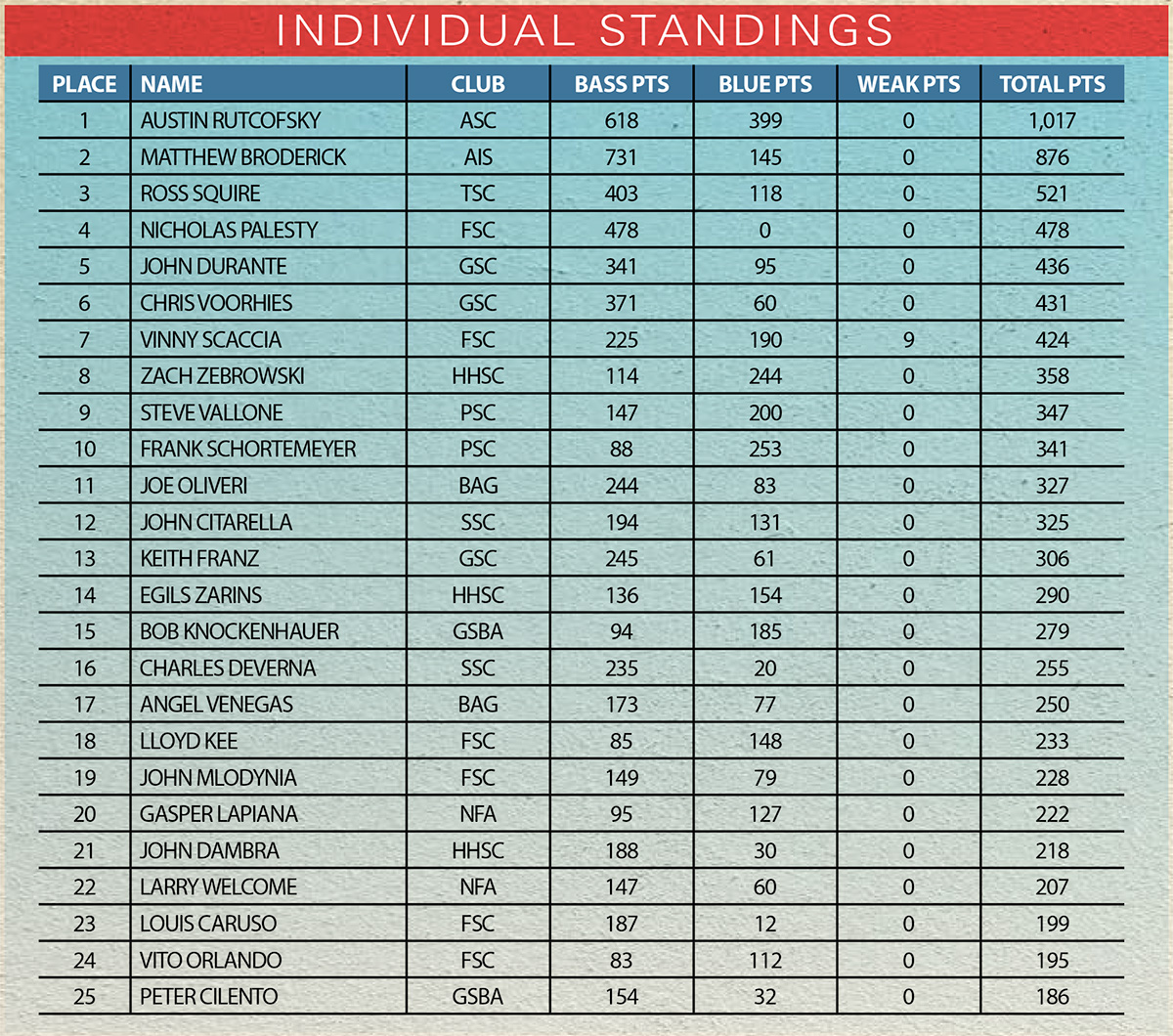
Conservation
The year 2015 was the first for New York’s new striped bass harvest regulation of one fish of at least 28 inches for all members of the recreational sector and a 25% reduction from the Amendment 6 quotas for the commercial sector. The new regulations are in response to the harvest reductions mandated by the Atlantic Marine Fisheries Commission (ASMFC) and were determined by the various states up and down the coast. The current fishing regulations will remain in place for 2018 with the next technical assessment to be completed in 2018 to gauge the effectiveness of the new regulations in rebuilding the striped bass fishery. At the past two ASMFC meetings, Chesapeake Bay and other states have complained about economic hardship they are facing from these new regulations and are maneuvering to have these regulations eased. A recent decision by the Secretary of Commerce overruling the science and ASMFC regulations on summer flounder or fluke in New Jersey sounds an ominous warning about what might be in store for striped bass.
While large numbers of very large striped bass were taken in the Cape Cod Canal throughout the summer and by boats in the rips off Montauk, the shoreline from Rhode Island through New Jersey was sparse with the exception of sub-legal stripers during the fall. It will be interesting to see if the very large numbers of schoolies that we experienced this fall will re-appear next spring and fall.
For 2017, the majority of angers practiced catch and release with 96.1 percent of fish released. Of the 1,112 fish that were entered this year, only 30 were harvested or were unable to be released. This speaks volumes about the demonstrated commitment to good stewardship of our fisheries among participants in the NYSFC.
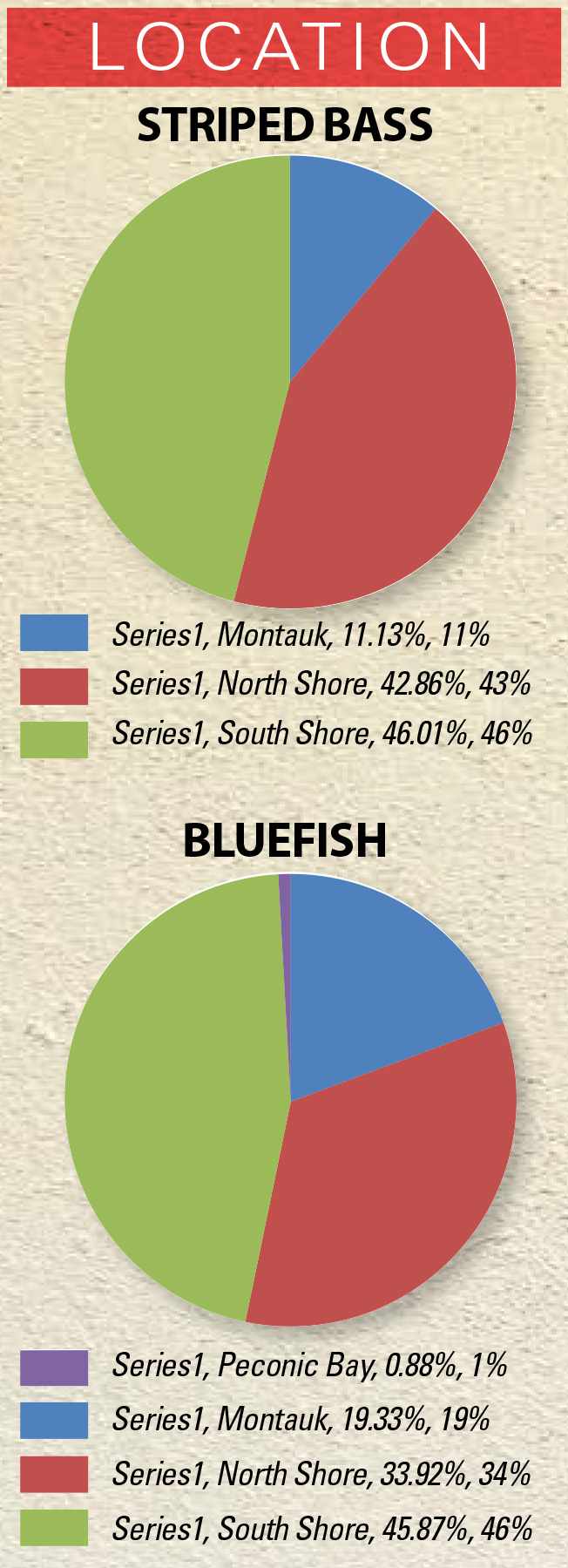
Looking Forward
The downward trend in all categories in 2017 is troubling and does not bode well for 2018. The decrease in bluefish during the fall months kept the bait offshore and as a result very few qualifying striped bass hit the beach for the majority of anglers. For the third year in a row, sand eels were relatively non-existent, and we can only hope that 2018 will see a resurgence in this bait. Sand eels are critical to a sustained run of fish. There are however some encouraging signs. We saw another strong year of peanut and adult bunker in our waters, and in recent years we have seen several decent young of year classes of striped bass in both the Hudson River and Chesapeake Bay; if these year classes can be protected, we could see an uptick in fishing success in the near future.
I would not be surprised to see the following as keys for success in 2018. There is no substitute for time on the water. With less fish in our waters, schools of fish will be widely disbursed.
When fish stocks are strong, skill and strategy play a big role in success. When the fish stocks are down a measure of luck and finding favorable conditions can often make the difference between a successful outing and a failed one. You will need to spend time to locate and capitalize on productive patterns and windows in different parts of Long Island. We can expect to see a similar showing of peanut and adult bunker in 2018, so having strategies for taking advantage of this bait would be wise. You must fish smart, focusing on the more favorable moon tides, wind conditions, bait patterns, etc.
